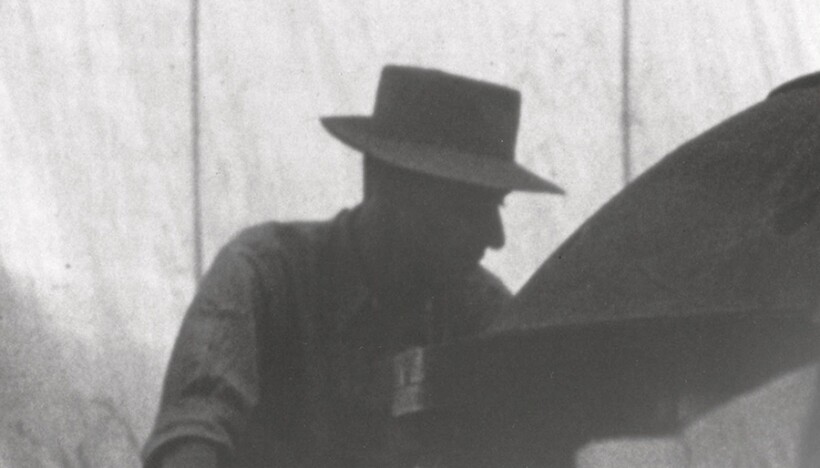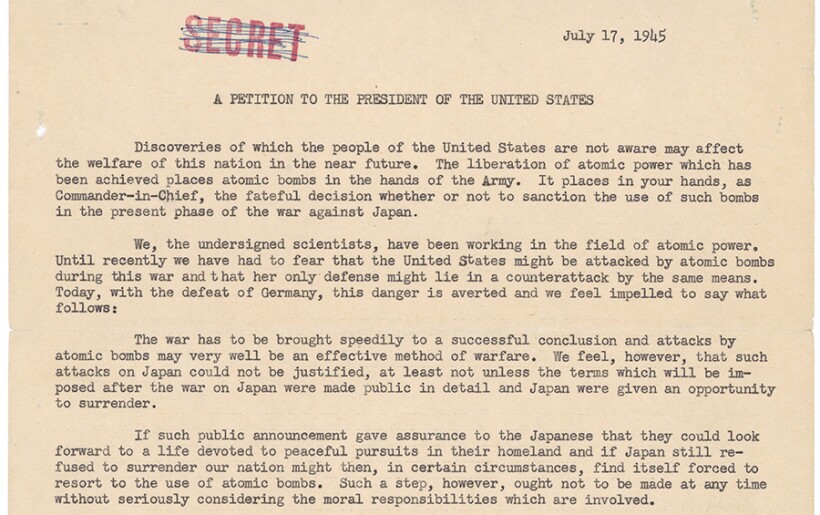Commentary: Why the fascination with Oppenheimer?

J. Robert Oppenheimer appears in this photo as a specterlike figure as he oversees the final assembly of the plutonium bomb that would be detonated in the Trinity test on 16 July 1945.
US Department of Energy/Wikimedia Commons
One of the pivotal scenes in Christopher Nolan’s Oppenheimer depicts the titular physicist’s 25 October 1945 meeting with President Harry S. Truman in the Oval Office. Truman welcomes Oppenheimer into the White House as the hero of the hour. But the meeting quickly goes south. Truman asks Oppenheimer when he thinks the Soviets will develop an atomic bomb. After Oppenheimer stammers and says he doesn’t know, Truman exclaims that they “never” will. Later in the conversation, Oppenheimer mentions that he feels he has “blood on my hands,” which angers Truman even more: “You didn’t drop the bomb, I did. Hiroshima isn’t about you.” When Oppenheimer is finally escorted out, Truman is heard muttering to Secretary of War Robert Patterson about the “crybaby” he’d just welcomed in.
In that scene, which is largely accurate, Truman comes off as an unfeeling rube who doesn’t fully understand the awesome power of atomic weapons. Viewers know his prediction that the Soviets would fail to develop the bomb was delusional. But Truman had a point when he said that Hiroshima wasn’t about Oppenheimer. The responsibility for dropping the bomb rested on the Truman administration and the US Army Air Forces.
We don’t often remember the individuals who design weapons, who typically have no control over how their creations are used. We remember the people who authorize their use. When we ponder whether the firebombings of Dresden, Hamburg, or Tokyo, for example, were justified, we don’t blame the people who developed the firebomb. We don’t even fault the pilots or bombardiers who dropped them. Blame is usually cast on the generals and politicians who okayed bombing civilian targets. It’s the same with weapons like assault rifles and machine guns: Even though they’ve killed millions more people in combat than atomic weapons have, we don’t blame the guns’ inventors.
So it was not a foregone conclusion in 1945 that Oppenheimer, Hans Bethe, Edward Teller, Leo Szilard, and the many other physicists who worked on the bomb would go down in history. It’s possible to envision a world in which the bombs were used on Japan and historical memory centered on Truman and other senior US leaders.

This famous sign, which Harry S. Truman kept on his Oval Office desk, memorializes one of his favorite phrases, “The buck stops here.” It emphasized his belief that the US president carried ultimate responsibility for the nation’s military actions.
Harry S. Truman Library, 64-1563
One reason Oppenheimer and his collaborators are so indelibly associated with the bomb is surely the weapon’s terrifying power. Another is early press coverage: William Laurence, a science reporter for the New York Times who witnessed the Trinity test, placed great emphasis
But those factors still don’t fully explain the fascination with Oppenheimer. A crucial reason why he remains so alluring is more intangible. It relates to the belief that as highly educated intellectuals, scientists are inherently morally upstanding. Despite plagiarism scandals, the #MeToo movement, and countless tales of bad behavior, scientists are still often assumed to be in the moral elite
If one believes that scientists are honorable paladins, then it’s jarring to think that members of that select group were the ones who developed a weapon that killed at minimum 110 000 people (a likely biased estimate
Unlike Haber, who never expressed remorse for his work on chemical weapons, many of the Manhattan Project scientists seemed to be ambivalent about their creation. Think of the quotation from the Bhagavad Gita that Oppenheimer claimed had popped into his head at the Trinity test: “Now I am become Death, the destroyer of worlds.” Although we’ll never know

Signed by 70 Manhattan Project scientists, the July 1945 Szilard petition to President Truman advocated giving Japan the opportunity to surrender before making the decision to drop the atomic bomb. This image includes only the first four paragraphs; the full one-page petition can be found here
US National Archives and Records Administration, 6250638/public domain
Both quotations express some amount of unease about the decision to develop and drop the atomic bomb—even though neither Oppenheimer nor Bainbridge expressed explicit regret for their wartime work. Countless other examples of atomic eloquence can be found: the June 1945 Franck Report,
So perhaps we remember Oppenheimer and his Manhattan Project colleagues precisely because their peculiarly eloquent expressions of apparent ambivalence about their creation—and the debate about whether using the bomb was justified—accord with the thoughtfulness and rationality that we expect from scientists. Perhaps we remember them because they appear to have acted the way we’d like morally upright scientists to act. They developed a horrible weapon, but only under duress: They thought the Nazis would get there first, and they wanted to end the most horrific war the world had ever seen. Moreover, when it came time to use it, many of them actively campaigned for the bomb to be demonstrated at a location with no threat to human life.
But we shouldn’t be so credulous. Although there was considerable debate among Manhattan Project scientists as to whether the bomb should be used, whatever qualms certain scientists may have had did not affect the course of the war. Neither Szilard’s petition nor the Franck Report made it to Truman’s desk. Even if they had, the idea that Truman and his advisers conferred one day and solemnly decided to drop the bomb is fallacious. From the start, the bomb was seen as a military weapon. There was no question over whether it would be used—only when it would be ready. It was hopelessly naïve of Oppenheimer to imagine that world powers could negotiate agreements ensuring international control over nuclear weapons. In the end, the Los Alamos physicists built a weapon capable of destroying the planet, and we’re still living with that reality today.